Henry Sticker - How to Calculate Quickly: Full Course in Speed Arithmetic
Here you can read online Henry Sticker - How to Calculate Quickly: Full Course in Speed Arithmetic full text of the book (entire story) in english for free. Download pdf and epub, get meaning, cover and reviews about this ebook. year: 1955, publisher: Dover Publications, genre: Children. Description of the work, (preface) as well as reviews are available. Best literature library LitArk.com created for fans of good reading and offers a wide selection of genres:
Romance novel
Science fiction
Adventure
Detective
Science
History
Home and family
Prose
Art
Politics
Computer
Non-fiction
Religion
Business
Children
Humor
Choose a favorite category and find really read worthwhile books. Enjoy immersion in the world of imagination, feel the emotions of the characters or learn something new for yourself, make an fascinating discovery.
- Book:How to Calculate Quickly: Full Course in Speed Arithmetic
- Author:
- Publisher:Dover Publications
- Genre:
- Year:1955
- Rating:3 / 5
- Favourites:Add to favourites
- Your mark:
How to Calculate Quickly: Full Course in Speed Arithmetic: summary, description and annotation
We offer to read an annotation, description, summary or preface (depends on what the author of the book "How to Calculate Quickly: Full Course in Speed Arithmetic" wrote himself). If you haven't found the necessary information about the book — write in the comments, we will try to find it.
Do you want to double or triple the speed with which you calculate? Can you run a rapid mental check over the results of your calculating machines? Can you check bills worked out for you by grocery store cash registers, on waiters checks, on department store charge accounts? Or do you simply take their word for the disposal of your money? Dont envy friends who can perform these calculations with lightning speed and complete accuracy. Theirs is not wholly an inborn ability. You can acquire these skills by the methods described in this book. How to Calculate Quickly is a tried and true method for helping you in the mathematics of daily life addition, subtraction, multiplication, division, and fractions.
The author can awaken for you a faculty which is surprisingly dormant in accountants, engineers, scientists, businessmen, and others who work with figures. This is number sense or the ability to recognize relations between numbers considered as whole quantities. Lack of this number sense makes it entirely possible for a scientist to be proficient in higher mathematics, but to bog down in the arithmetic of everyday life.
This book teaches those necessary mathematical techniques which schools neglect to teach: Horizontal addition, left to right multiplication and division, etc. You will learn a method of multiplication so rapid that youll be able to do products in not much more time than it would take to write the problem down on paper.
This is not a collection of tricks which work in only a very few special cases; but a serious, capably planned course of basic mathematics for self-instruction. It contains over 9,000 short problems and their solutions for you to work on streetcars, in taxis, at lunch, during spare moments. Five or ten minutes spent daily on this book will, within ten weeks, give you a number sense that will double or triple your calculation speed.
Henry Sticker: author's other books
Who wrote How to Calculate Quickly: Full Course in Speed Arithmetic? Find out the surname, the name of the author of the book and a list of all author's works by series.

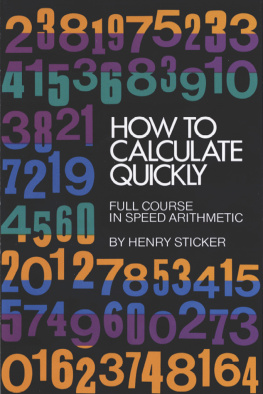

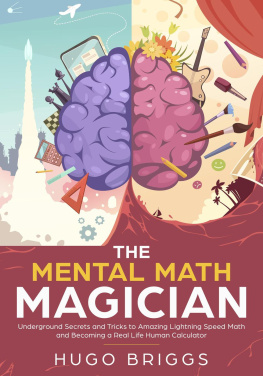
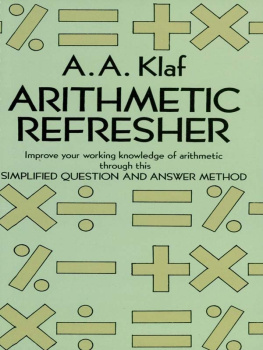
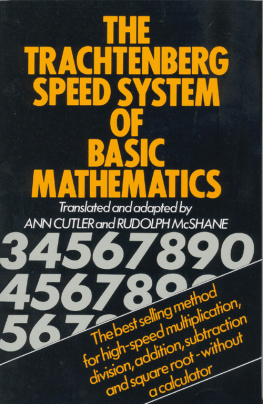
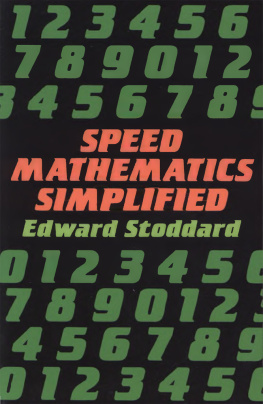

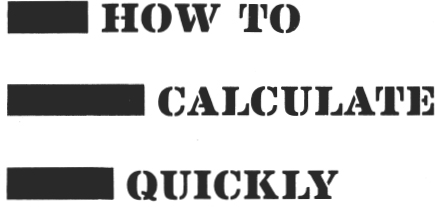 (the art of calculation) BY HENRY STICKER DOVER PUBLICATIONS, INC. This Dover edition, first published in 1955, is an unabridged republication, with minor corrections, of the work originally published by Essential Books in 1945 under the title The Art of Calculation. It is reprinted through special arrangement with Duell, Sloan and Pearce, Inc. Copyright Copyright 1945 by Essential Books. Copyright 1955 by Dover Publications, Inc. All rights reserved. International Standard Book NumberISBN-13: 978-0-486-20295-2ISBN-10: 0-486-20295-X Manufactured in the United States by Courier Corporation 20295X35 www.doverpublications.com PREFACE Arithmetic is a science, but calculation is an art.
(the art of calculation) BY HENRY STICKER DOVER PUBLICATIONS, INC. This Dover edition, first published in 1955, is an unabridged republication, with minor corrections, of the work originally published by Essential Books in 1945 under the title The Art of Calculation. It is reprinted through special arrangement with Duell, Sloan and Pearce, Inc. Copyright Copyright 1945 by Essential Books. Copyright 1955 by Dover Publications, Inc. All rights reserved. International Standard Book NumberISBN-13: 978-0-486-20295-2ISBN-10: 0-486-20295-X Manufactured in the United States by Courier Corporation 20295X35 www.doverpublications.com PREFACE Arithmetic is a science, but calculation is an art.  . As soon as money enters into the matter you immediately see the whole picture in a different light. If you were asked approximately how much your commissions amounted to, you would figure quick as a flash that 11 times 12 is 132, and you would probably answer instantly that you had made something over $132. If you were then asked how much over $132, you would either figure that 62
. As soon as money enters into the matter you immediately see the whole picture in a different light. If you were asked approximately how much your commissions amounted to, you would figure quick as a flash that 11 times 12 is 132, and you would probably answer instantly that you had made something over $132. If you were then asked how much over $132, you would either figure that 62 are
are  of one dollar, or else that this amount is equal to half a dollar plus
of one dollar, or else that this amount is equal to half a dollar plus  of a dollar. You would not take long in determining that the excess over $132 comes to $7
of a dollar. You would not take long in determining that the excess over $132 comes to $7